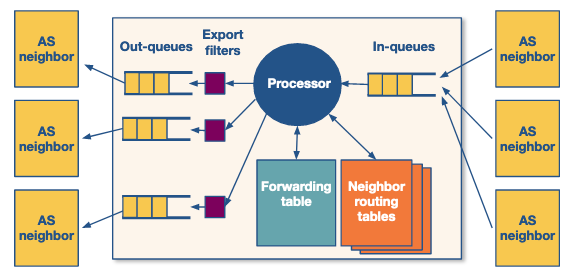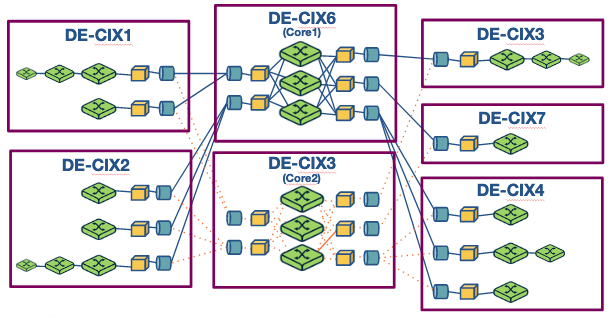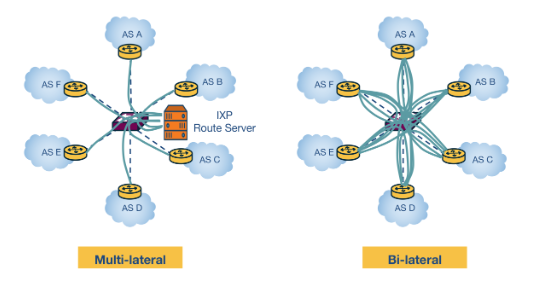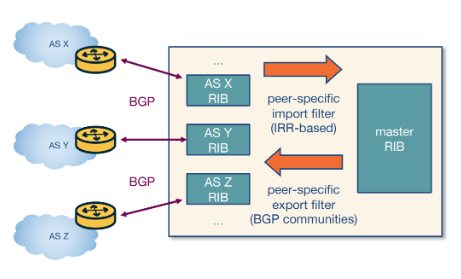Week 4 - AS relationships and interdomain routing
Interdomain routing
Link to originalInterdomain routing
This is the process of routing between Autonomous system (AS). Here there is a lot of commercial pressure on the decision of which routes to offer. The protocols that are used for this are called Boarder gateway protocol (BGP).
Additional reading
Important Readings
Interdomain Internet Routing
https://web.mit.edu/6.829/www/currentsemester/papers/AS-bgp-notes.pdfLinks to an external site.
BGP routing policies in ISP networks
https://www.cs.princeton.edu/~jrex/papers/policies.pdfLinks to an external site.
On the importance of Internet eXchange Points for today’s Internet ecosystem
https://cryptome.wikileaks.org/2013/07/ixp-importance.pdfLinks to an external site.
Peering at Peerings: On the Role of IXP Route Servers
https://people.csail.mit.edu/richterp/imc238-richterA.pdfLinks to an external site.
Book References
Kurose-Ross
6th Edition: Section 1.3.3 (A Network of Networks), Section 4.6.3 (Inter-AS Routing: BGP)
7th Edition: Section 1.3.3 (A Network of Networks), Section 5.4.1 (The Role of BGP)
Optional Readings
Investigating Interdomain Routing Policies in the Wild
https://people.cs.umass.edu/~phillipa/papers/AnwarIMC15.pdfLinks to an external site.
BGP Communities: Even more Worms in the Routing Can
https://people.mpi-inf.mpg.de/~fstreibelt/preprint/communities-imc2018.pdfLinks to an external site.
On the scalability of BGP: the roles of topology growth and update rate-limiting
https://www.cc.gatech.edu/home/dovrolis/Papers/bgp-scale-conext08.pdfLinks to an external site.
O Peer, Where Art Thou? Uncovering Remote Peering Interconnections at IXPs
https://www.inspire.edu.gr/wp-content/pdfs/uncovering_remote_peering_interconnections_v1.pdfLinks to an external site.
Detecting BGP Configuration Faults with Static Analysis
https://www.usenix.org/legacy/events/nsdi05/tech/feamster/feamster.pdfLinks to an external site.
Ecology of the internet
The internet has 3 major players:
Internet Service Provider (ISP)
Link to originalInternet Service Provider (ISP)
An internet service provider (ISP) is a company that provides individuals and organizations access to the Internet and other related services.
There are different size internet service providers and the lines between them are not always clear:
- Global (Tier 1) ISP: These form the backbone of the internet.
- Regional (Tier 2) ISP: These offer services in one particular area.
- Access (Tier 3) ISP: These offer access to individuals to the internet.
Content delivery network (CDN)
Link to originalContent delivery network (CDN)
These are distribution networks that large content providers use to guarantee consistent converge across a region. This is due to the provider having more control of how the network is connected and lowering the costs of distribution.
Internet Exchange Points (IXPs)
Link to originalInternet Exchange Points (IXPs)
Each of these may operate as one AS or as multiple to allow different protocols to be used in different parts of the network.
Cooperation and competition among networks
Whilst ISPs are in direct competition with eachother they also can not operate without cooperating with each other also. The ISP business model is based off selling access to internet - this is normally calculated via bandwidth used either for a fixed price with a cap or by taking the 95th percentile of measurements normally taken every 5 minutes. Either of these mean the ISP has incentives to make you use their service more. This relies on you having low latency connections to as many other hosts as possible.
The cost to ISPs is maintaining a network with sufficient capacity to handle all that traffic. Therefore unless traffic is going to a host paying them they will need a commercial incentive to carry it.
Therefore two types of relationships form between ISPs
- Peering relationships: If two providers see hosts exchange traffic between there networks in roughly equal quantities they may agree to share traffic directly at no cost between the ISPs.
- Customer-Provider relationships: If one ISP has considerably more hosts receiving traffic then they can sell access to these hosts to other ISPs. Here the larger ISP becomes the provider to the smaller customer ISP and picks up a fee.
This has been the model since the beginning of the internet and was one of the main drivers for the hierarchical nature of ISPs and the internet as a whole. However IXPs are changing this. IXPs mean that ISPs don’t need to go through eachother and instead can trade traffic directly. This is making the internet more flat. This is in part driven by CDNs using IXPs to have the lowest latency connections to their consumers.
Address exchange
First consider which addresses AS want to exchange with other internet entities.
Exporting routes
First lets look at what routes an AS would want to tell other internet entities about. This has financial repercussions as you will then have to carry that traffic on your network.
- Routes form customers: These are profitable for an ISP to share as they generate revenue from more traffic going to these. These are shared willingly to all.
- Routes from peers: Whilst there is the network cost of carrying this traffic sharing these addresses keeps the free agreements in place or can turn peers into customers. It may make sense to share routes learnt from peers but it is circumstantial.
- Routes from providers: A provider is paying for access to the provider. It has very little commercial incentive to share routes learnt from the provider.
Importing routes
When an AS decides which route to send its traffic down this again is a symmetric decision to exporting. The goal of the AS is for the traffic of its customers to travel through the fewest other AS as possible as each one will generate it some cost and potentially reduce capacity of the route.
- Route offered by peer or customer: These in the short term are completely free and so will preferably use these.
- Route offered by provider: These cost the AS money so will be used as a last resort.
Protocols
Interdomain routing
Link to originalInterdomain routing
This is the process of routing between Autonomous system (AS). Here there is a lot of commercial pressure on the decision of which routes to offer. The protocols that are used for this are called Boarder gateway protocol (BGP).
Boarder gateway protocol (BGP)
Link to originalBoarder gateway protocol (BGP)
This is a class of protocols that are used for interdomain routing. That is sharing subnets between AS. Two routers connected over BGP are called BGP peers. They open a semi-permanent TCP connection where they exchange routes. There are two varieties of this class.
- iBGP: For internal to the AS communication between boarder routers.
- eBGP: For two routers who are in different AS. The difference between iBGP and IGP is that iBGP is communicating about what external subnets are available from that router wheres IGP is communicating about what internal subnets there are.
The goals of BGP are:
- Scalability: How do you maintain a routing table when the size of the internet is expanding.
- Expressing route policies: How do we allow for AS to control which routes to use and to broadcast.
- Cooperation: To let AS to make local decisions with the information they are provided.
- Security: Whist not an initial design goal BGP did not include security as the internet has expanded it has become more important. This needs to protect AS from malicious attacks, misconfiguration, and faults. This includes different protocols, registries for the domains an AS owns, private keys for AS.
The BGP protocol
Two routers connected over BGP are called BGP peers. They open a semi-permanent TCP connection where they exchange routes. There are two different varieties.
- iBGP: For internal communication about what external routes are available.
- eBGP: For communicating with other AS.
There are three important messages BGP has.
- The OPEN message to start the conversation.
- The UPDATE message that contains a change of available routes. This has two forms:
- Announcements about new routes or updates to old routes.
- Withdrawls messages about routes no longer available.
- The KEEPALIVE messages that keep the connection going.
In the BGP the routers exchange IP prefixes that represent subnets or collections of subnets if the router is using route summarization. For the routes agreed by the AS the router offers theses over eBGP and then shares the routes it has been offered over iBGP.
Messages passed between AS have some special properties, two of which are:
- ASPATH: A list of ASN for each AS the route has passed through. This is helpful to avoid loops.
- NEXTHOP: The IP address of the next router in the hop.
The router process
We can model a router running BGP as follows.

This has 3 main steps.
- Receive and store neighbours routing tables.
- Decides its best routing options and updates the forwarding table.
- Decides which routes it wants to advertise and updates neighbouring routers.
How a router decides which route to use depends on many factors. It ranks these and then compares routes.
| Step | Attribute | Controller? |
|---|---|---|
| 1 | Highest LocalPref | local |
| 2 | Lowest AS path length | neighbour |
| 3 | Lowest origin type | neither |
| 4 | Lowest MED | neighbour |
| 5 | eBGP-learned over iBGP-learned | neither |
| 6 | Lowest IGP cost | local |
| 7 | Lowest router ID (break ties) | neither |
There are two main ways AS can control which routes it uses and its neighbours uses.
LocalPref
This is how an AS expresses its commercial best interest. It will set a value to neighbouring AS based on the financial relationship it has with it. These normally are:
| Relationship to advertising AS | LocalPerf value |
|---|---|
| Customer | 90-99 |
| Peer | 80 - 89 |
| Provider | 70 - 79 |
| Backup links | 60-69 |
This reflects the preferences we discussed above, customer then peer then provider.j
Multi-exit Discriminator (MED)
If an AS has two routers connecting to a neighbours AS which are offering some of the same routes. Knowing the forwarding tables of these routers may give a preference for how a neighbouring AS forwards traffic through your network. This is controlled by setting a MED value (for example as the IGP cost to forward that traffic).
Challenges with BGP: Misconfiguration and scalability
Routers are vulnerable to misconfiguration and faults. This can lead to an excessively large number of updates leading to further faults from overloading the network. This can be mediated by limiting the size of the routing table.
To limit the size of the routing table it can filter out routes that are too specific. This encourages route summarization. The act of route summarization protects the whole network from getting overloaded and help with scalability. Small AS sometimes just use a default gateway where they redirect all traffic without further knowledge.
If a route is repeatedly updated due to some route instability this can risk messages getting sent in error or a patchy connection. Routers can implement flap damping where it tracks the number of updates to a prefix. If this goes over a certain threshold in a time interval it will suppress that route until it stabilises.
Routers can be strategic about what addresses it does this too and how sensitive it is. If it has addresses it needs to have high availability for it can have a much higher threshold whereas other addresses it can be much lower.
Peering at an IXP
Internet Exchange Points (IXPs)
Link to originalInternet Exchange Points (IXPs)
Below is an example of such and IXP is Frankfurt.

This shows how an IXP is a massive set of switches creating a giant network. It is normally distributed over a region or globally with different connection points such as DE-CIX1,2,3,4,7 all connecting in to a fault tolerant core Core 1 with backup Core2.
To exchange with an IXP a AS needs to physically connect with it. Which is why being distributed makes this easier though carries technical cost to it.
IXPs have become increasingly popular, why?
- IXP can handle large quantities of traffic rivalling that of tier-1 ISPs.
- IXP can mitigate DDoS attacks by monitoring traffic to particular ASs.
- They provide excellent research hubs due to their open and large scale nature.
- They are active marketplaces offering services to the ASs that participate in them. This offering is expanding as more research happens providing innovation to the internet.
How to peer at an AS
An AS must have an ASN to peer at an IXP. Then they will need to physically collocate a router in the AS to one of the IXP access points. Lastly they must agree to the terms and conditions of using the IXP. To do this they pay:
- A one off access cost to locate the router at the access point,
- A monthly fee for renting a port - this cost normally scales based on the speed/capacity of that port.
- Sometimes there is a yearly subscription fee.
Once connected to the IXP there is normally no cost to publicly peer there. That means getting access to all the other networks also publicly peering there.
Normally the terms of accessing do not forbid reselling of access to the IXP. Therefore some providers link with an IXP the resale access to that IXP if it is too hard for another AS to collocate a router there. This is called remote peering and is an active area of study.
Why peer in an IXP
- Keeps traffic local which is more reliable and faster.
- Lower costs than negotiating with other ASs such as ISP for access.
- Incentives - large content providers prefer use of IXP as it guarantees more control of how their users receive their content. Therefore they connect via IXPs which motivates other actors to use them.
Services offered by an IXP
- Public peering: This allows you to directly connect with any other participant who is also public peering opening up a massive number of new routes but also direct connections with other ASs.
- Private peering: This allows for direct connection between two parties who know eachother at the IXP. This won’t use the pubic peering infrastructure. Though provides a high capacity stable connection.
- Route servers and Service level agreements: Normally the IXP will offer free access to a route server which is a giant public route table. The IXP will also offer SLAs with the services they offer.
- Mobile peering: This is a scalable solution to mobile networks.
- DDoS black-holing: This is a customer triggered black-holing of traffic coming towards their AS to relieve the stress from DDoS attacks.
- Free value add services: Services that are for the public good like bandwidth testing, Internet Routing Registries,DNS servers, ect.
How do route servers work
Two ASs in a IXP to transfer route information need to establish a bilateral BGP connection. However with so many participants at an IXP the number of open connections would be massive - which would not scale.

Instead if the IXP offers a route server ASs connect to this single entity instead. This offers the following services:
- It collects and shares routing information from its peers.
- It execute BGP decisions and re-advertises the resulting information.
The collection of addresses is called a Routing Information Base (RIB) which contains all BGP paths. There is a master RIB with all the information and an AS specific RIB for each participant.
Route servers maintain two types of route filters. Import route filters that allow ASs to only advertise routes they should advertise. Export route filters which are triggered by member ASs to restrict which other IXP members can receive their routes.
For example suppose AS X and AS Y exchange routes through a multi-lateral peering session through a route server. This happens in the following steps.
- First AS X advertises a prefix p1 to the route server, which is added to the route server’s RIB for that AS.
- The route server checks AS X import filters to see if it wants to advertise p1 - if so it is added to the master RIB.
- The route server checks AS X’s export filters to see if AS Y is allowed to recieve p1. If so it adds it to AS Y’s RIB.
- Lastly the route server advertises p1 to AS Y with AS X as the next hop.
